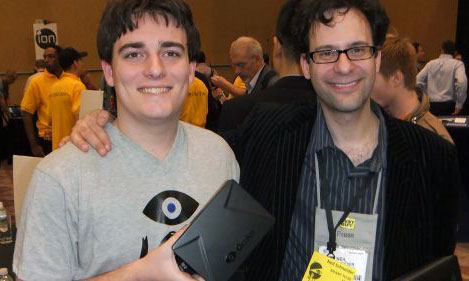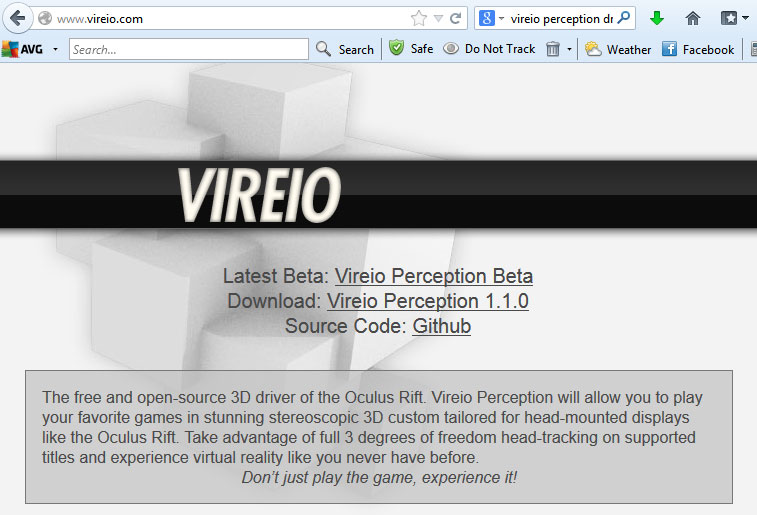3D, Virtual Reality, And Immersive Technology At The U Of OIT
Neil Traces The History Of Oculus Rift And Vireio Perception
Tom's Hardware: How is Meant to be Seen connected to the Oculus Rift?
Neil Schneider: Palmer Luckey has been a longtime moderator in MTBS' forums. There are several volunteers who help make it possible for the organization to function, and he's one of them. We found that there was a lot of interest in virtual reality devices and do-it-yourself ideas, so we created a special VR section in MTBS' forums a few years ago. That community quietly grew and grew without anyone really knowing about it.
This is where John Carmack and Palmer Luckey first met and where the Oculus Rift was born. Our community was also the launching pad for Virtuix Omni, some VR independent game developers, the Minecraft VR mod, and more. There is also another head-mounted display in the works by Anton Lionel called the "InfiniteEye". It features even more field of view than the Oculus Rift developer kit, and is built with high-resolution panels. Watch for it!
Tom's Hardware: Tell us about MTBS' involvement in the Vireio Perception Driver.
Neil Schneider: Another one of our moderators is Andres Hernandez (Cybereality). Before getting hired by Oculus VR as their community manager, he developed VR drivers for head-mounted displays (HMDs) that he called Vireio Perception. It's similar to the software developed by DDD TriDef and Nvidia 3D Vision; it lets you take existing games and play them in stereoscopic 3D, even if they aren't designed for that. The Vireio Perception drivers are intended for VR devices with head-tracking features. Andres released them as open source, and the MTBS community is responsible for further development.
These drivers got a lot of media attention for making it possible to play Skyrim, Left 4 Dead, and Mirror's Edge with HMDs like the Oculus Rift. Unfortunately, they had issues. We've encountered some major bumps and jumps in development, and learned a few important lessons about open source. The troublesome sync issue is now fixed with a new architecture, and our current developers Denis Reischl and Joshua Brown documented the entire driver so others could help continue development in an efficient manner.
The group has never been as organized as it is now, and I'm very excited because Vireio isn't just imitating what is already out there. The team is developing new techniques and ideas that we haven't seen in stereoscopic 3D or VR drivers before. We are very close to a "proof of concept" public build, but we really need more programmers with DirectX knowledge to lend their support. Once the structural roots are laid down, we think there is a lot of community growth potential for this software and VR gamers at large.
Get Tom's Hardware's best news and in-depth reviews, straight to your inbox.
A lot of talented people have been hired straight from our forums. Andres, Palmer, Dycus, and Brantlew all got plucked from MTBS. Vireio is a good way to show your stuff and get noticed. Please email lendahand@mtbs3d.com with Vireio in the title if you are interested in helping out.
Current page: Neil Traces The History Of Oculus Rift And Vireio Perception
Prev Page Neil Schneider Gets His Start In 3D Next Page Neil On Where Immersive Technology Is HeadingDon Woligroski was a former senior hardware editor for Tom's Hardware. He has covered a wide range of PC hardware topics, including CPUs, GPUs, system building, and emerging technologies.
-
xkm1948 Hopefully the development of neuroscience will help sending signals directly to one's cortex without being processed by vision system. It is already doable in auditory system, although it is still indirectly stimulus of cortex. With a better understanding of cortex mapping, we may finally be able to get signals directly into brain without all the sensory organs!Reply -
clonazepam baby steps... baby steps. I dont see how that's possible without destroying healthy brain tissue during the learning process, so it'll never happen. Maybe some lab rats might get to enjoy some corridor run-throughs from the latest ID software, Quake 37 or something, but that's about it.Reply
I like the idea of several companies coming together to build a market to share with each other. That'd be nice. I've got a 3D Vision ready monitor and glasses. I messed around with it some when I first got it, but the quality of the experience from one game to the next was anything but consistent. Longer play sessions were interrupted by having to recharge the glasses too.
I'm still hopeful that we get there someday. It's nice to know there's a group of people out there to decide where "there" is, and help define it as we move toward it. -
piklar Bunch o Chickmagnets.... things will get interesting when Occy R goes retail , cant help but think they will be hard pressed to keep up with demand "how could you NOT want one?" exciting times ahead..Reply
-
bystander ReplyHopefully the development of neuroscience will help sending signals directly to one's cortex without being processed by vision system. It is already doable in auditory system, although it is still indirectly stimulus of cortex. With a better understanding of cortex mapping, we may finally be able to get signals directly into brain without all the sensory organs!
While that may be interesting, and very useful for the blind, part of the experience we have with 3D is processing it in the same manner we do in real life. Through our eyes.
I am a big fan of 3D Vision myself. I really wish all the poor versions of 3D never existed, so people would stop calling it bad or a gimmick, because in the right games, it is truly awesome. 3D Vision has a great mod community that fixes a lot of games too, using the Helix mod, for those into 3D, it is a must to use their mods. -
bnot "Back in 2007, 3D was in the hands of hardcore fringe enthusiasts, and reliable information was very had to come by." ?Reply
http://en.wikipedia.org/wiki/Virtuality_(gaming)
Virtuality is a line of virtual reality gaming machines produced by Virtuality Group, and found in video arcades in the early 1990s. The machines deliver real time (less than 50ms lag) gaming via a stereoscopic visor, joysticks, and networked units for multi-player gaming.
Initially introduced in 1991, the systems were developed for industry, where the first two networked systems were sold to British Telecom Research Laboratories to experiment with networked telepresence applications. Many other systems were sold to corporations including Ford, IBM, Mitsubishi and Olin. Professional virtual reality systems included the launch of the Ford Galaxy in virtual reality and a virtual trading floor for the London International Financial Futures and Options Exchange (LIFFE). However, the users' thrill of talking and mutually interacting with each other as virtual characters refocused the company's direction.....
http://www.cybermind.nl/Our%20Products/VR%20LBE%20Systems/visette_01.gif
-
Shankovich Wat UOIT is doing this stuff? LOL wow I should go visit. When I was applying to university 4 years ago they were offering insane entering scholarships because they were so new, $8000 a year if you had an average above 90%. Glad to see they're doing so well!Reply -
Verrin I went to UOIT for nuclear science. It's a neato school, the high costs of tuition is because you're renting a laptop with expensive software suites on it (cost is more for the software than the hardware). I sort of cringed everytime the author said "U of OIT". No one calls it thaaaaaat. It's UOIT.Reply

